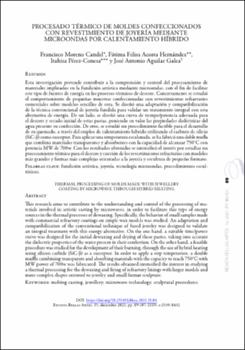Procesado térmico de moldes confeccionados con revestimiento de joyería mediante microondas por calentamiento híbrido
Fecha
2021Resumen
Esta investigación pretende contribuir a la comprensión y control del procesamiento de
materiales implicados en la fundición artística mediante microondas, con el fin de facilitar
este tipo de fuentes de energía en los procesos térmicos de descere. Concretamente se estudió
el comportamiento de pequeñas muestras confeccionadas con revestimientos refractarios
comerciales sobre modelos sencillos de cera. Se diseñó una adaptación y compatibilización
de la técnica convencional de joyería fundida para validar un tratamiento integral con esta
alternativa de energía. De un lado, se diseñó una curva de tiempo/potencia adecuada para
el descere y secado inicial de estas pastas, poniendo en valor las propiedades dieléctricas del
agua presente su confección. De otro, se estudió un procedimiento factible para el desarrollo
de su quemado, a través del empleo de calentamiento híbrido utilizando el carburo de silicio
(SiC-β) como susceptor. Para aplicar una temperatura escalonada, se ha fabricó una doble mufla
que combina materiales transparentes y absorbentes con la capacidad de alcanzar 750°C con
potencia MW de 700w. Con los resultados obtenidos se intensificó el interés por estudiar un
procesamiento térmico para el descere y cocción de los revestimientos refractarios con modelos
más grandes y formas más complejas orientadas a la joyería y escultura de pequeño formato. This research aims to contribute to the understanding and control of the processing of ma-
terials involved in artistic casting by microwaves, in order to facilitate this type of energy
sources in the thermal processes of dewaxing. Specifically, the behavior of small samples made
with commercial refractory coatings on simple wax models was studied. An adaptation and
compatibilization of the conventional technique of fused jewelry was designed to validate
an integral treatment with this energy alternative. On the one hand, a suitable time/power
curve was designed for the initial dewaxing and drying of these pastes, taking into account
the dielectric properties of the water present in their confection. On the other hand, a feasible
procedure was studied for the development of their burning, through the use of hybrid heating
using silicon carbide (SiC-β) as a susceptor. In order to apply a step temperature, a double
muffle combining transparent and absorbing materials with the capacity to reach 750°C with
MW power of 700w was fabricated. The results obtained intensified the interest in studying
a thermal processing for the dewaxing and firing of refractory linings with larger models and
more complex shapes oriented to jewelry and small format sculpture.






